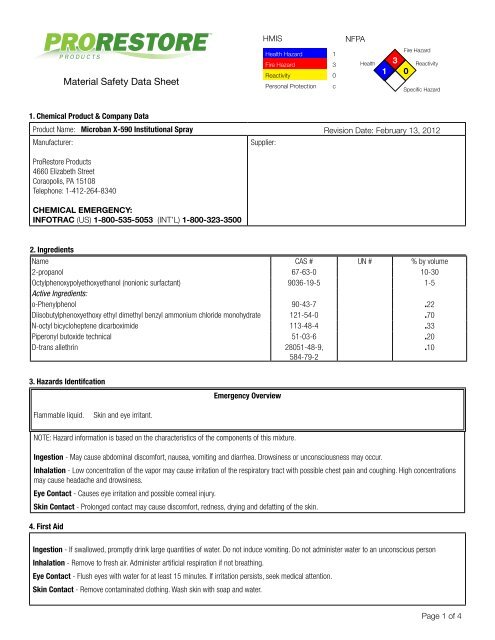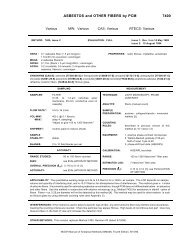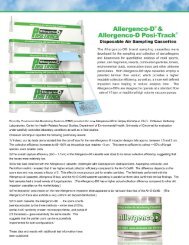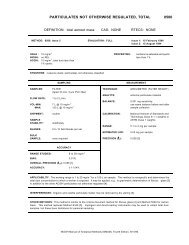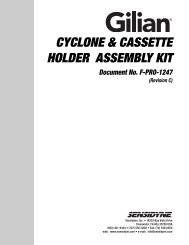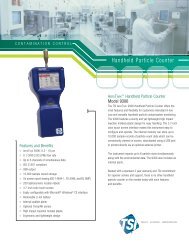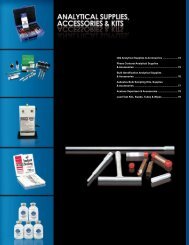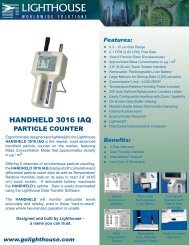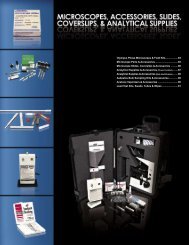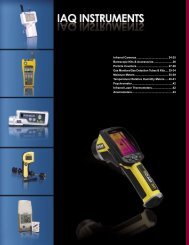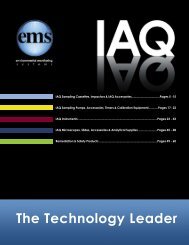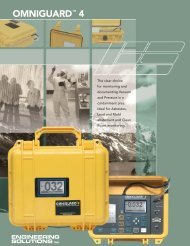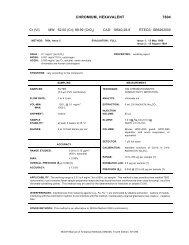Material Safety Data Sheet
Microban X-590 Institutional Spray (ems Product ID 120945)
Microban X-590 Institutional Spray (ems Product ID 120945)
Create successful ePaper yourself
Turn your PDF publications into a flip-book with our unique Google optimized e-Paper software.
HMISNFPA<strong>Material</strong> <strong>Safety</strong> <strong>Data</strong> <strong>Sheet</strong>Health Hazard 1Fire Hazard 3Reactivity 0Personal Protection cHealth13Fire Hazard0ReactivitySpecific Hazard1. Chemical Product & Company <strong>Data</strong>Product Name: Microban X-590 Institutional SprayManufacturer:ProRestore Products4660 Elizabeth StreetCoraopolis, PA 15108Telephone: 1-412-264-8340CHEMICAL EMERGENCY:INFOTRAC (US) 1-800-535-5053 (INT’L) 1-800-323-3500Supplier:Revision Date: February 13, 20122. IngredientsName CAS # UN # % by volume2-propanol 67-63-0 10-30Octylphenoxypolyethoxyethanol (nonionic surfactant) 9036-19-5 1-5Active Ingredients:o-Phenylphenol 90-43-7 .22Diisobutylphenoxyethoxy ethyl dimethyl benzyl ammonium chloride monohydrate 121-54-0 .70N-octyl bicycloheptene dicarboximide 113-48-4 .33Piperonyl butoxide technical 51-03-6 .20D-trans allethrin 28051-48-9,584-79-2.103. Hazards IdentifcationEmergency OverviewFlammable liquid.Skin and eye irritant.NOTE: Hazard information is based on the characteristics of the components of this mixture.Ingestion - May cause abdominal discomfort, nausea, vomiting and diarrhea. Drowsiness or unconsciousness may occur.Inhalation - Low concentration of the vapor may cause irritation of the respiratory tract with possible chest pain and coughing. High concentrationsmay cause headache and drowsiness.Eye Contact - Causes eye irritation and possible corneal injury.Skin Contact - Prolonged contact may cause discomfort, redness, drying and defatting of the skin.4. First AidIngestion - If swallowed, promptly drink large quantities of water. Do not induce vomiting. Do not administer water to an unconscious personInhalation - Remove to fresh air. Administer artificial respiration if not breathing.Eye Contact - Flush eyes with water for at least 15 minutes. If irritation persists, seek medical attention.Skin Contact - Remove contaminated clothing. Wash skin with soap and water.Page 1 of 4
Microban X-590 Institutional Spray5. Fire Fighting MeasuresFlammabilityYes X NoIf yes, under which conditions?Flammable liquid. Potential fire hazard when exposed to excessiveheat, flame or other sources of ignition.Flashpoint:77 °F (25 °C)Autoignition temperaturen. av.Upper flammable limit% by volume n. av.Hazardous combustion productsCarbon monoxide and/or carbon dioxideLower flammable limit% by volume n. av.Explosion datan. ap.Means of extinction:Apply alcohol type or all purpose foam for large fires. Use dry chemical media or carbon dioxideextinguishers for small fires. SCBA and bunker gear for fire department personnel6. Accidental Release MeasuresEliminate all sources of ignition.Wear personal protective equipment.Do not allow spill to reach watercourse or sewers.Contain spill with absorbent mats or booms or inert materials such as sand. <strong>Material</strong> should be readily available in theworkplace.Collect and store waste materials in suitable containers for disposal i.e. metal drums.7. Handling & StorageStore in a cool dry place.Keep containers closed and away from heat or flame.Do not use or store near open flame.8. Exposure Controls & Personal ProtectionGlovesNatural RubberFootwearn. ap.*none established for product*Limit values in other countries:Personal Protective EquipmentRespiratorIn processes where mists or vapors may begenerated, a NIOSH/MSHA jointly approvedrespirator is advised in the absence of properenvironmental controls.ClothingCoveralls or equivalentExposure GuidelinesOSHAEyeGoggles or full face respiratorOthern. ap.ACGIHTWA STEL TWA STEL2-propanol 400 ppm 500 ppm 400 ppm 500 ppm2-propanol UK OES (8 hr TWA) 999 mg/m 32-propanol Australia (8 hr TWA) 500 mg/m 3 Page 2 of 4
Microban X-590 Institutional Spray13. Disposal ConsiderationsDispose of in compliance with all Federal, state, and local laws and regulations.14. Transport InformationShipping Name:Hazard Class:UN Identification #:Only quarts and gallons ship as Consumer Commodity ORM-D for ground shipments in the United States.FLAMMABLE LIQUIDS, N.O.S. (iSOPROPANOL)3 (Packing Group III)UN199315. Regulatory InformationThis material safety data sheet has been prepared in accordance with the requirements of the OSHA Hazard Communication Standard (29 CFR1910.1200) and the Hazardous Products Act (Can.) and the Controlled Products Regulations (Can.)Federal Level Regulations: This is an EPA FIFRA registered pesticide (EPA Registration No. 70385-3). This material can only be used commercially inthe EPA registered application(s) noted on the product label.This product is classed as a flammable liquid and as a skin and eye irritant - 29 CFR 1910.1200 and Controlled Products Regulations (Can.)This product is not subject to the reporting requirement of Section 313 of Title III of Superfund Amendments and Reauthorization Act (SARA) 1986 and40 CFR part 372.California Proposition 65:Warning! This product contains chemical(s) known to the state of California to be Carcinogenic.Weight% Components CAS No.2 PPM 1,4 Dioxane 123-91-1.22% o-Phenylphenol 90-43-7Carcinogenic EffectsFor Component: o-PhenylphenolOrtho-phenylphenol and Sodium ortho-phenylphenol were tested in accordance with the EPA Final Guidance for Carcinogenic Risk. OPP and Na-OPP were classified as “Not Likely to be Carcinogenic to Humans” based on no evidence of carcinogenic effects at the defined dose range of 200mg/kg/day. At doses greater than 200 mg/kg/day, OPP and Na-OPP were classified as “Likely to be Carcinogenic to Humans” based on the presenceof urinary bladder tumors in rats and the presence of liver tumors in mice.Carcinogenicty:No Carcinogenic substances as defined by IARC, NTP and/or OSHA.16. Other InformationThis product is a disinfectant, insecticide and deodorant.Abbreviations:n. av. = not available n. ap. = not applicable ppm = parts per millionmm Hg = millimeters of Mercury PMCC = Pensky Martens Closed Cup TCC = Tagliabue Closed CupCOC = Cleveland Open Cup TWA = Time Weighted Average STEL = Short Term Exposure LimitLD = Lethal DoseLC = Lethal ConcentrationThis information is furnished without warranty, expressed or implied except that it is accurate to the best knowledge of ProRestore Products. The data and information on this sheet relates only to the specific material designated herein. ProRestoreProducts assumes no legal responsibility for use or reliance upon this data.Page 4 of 4


